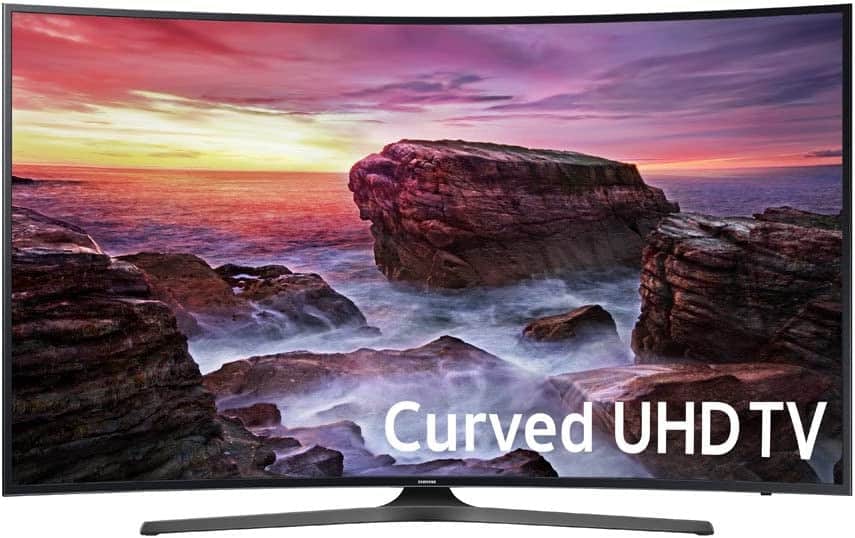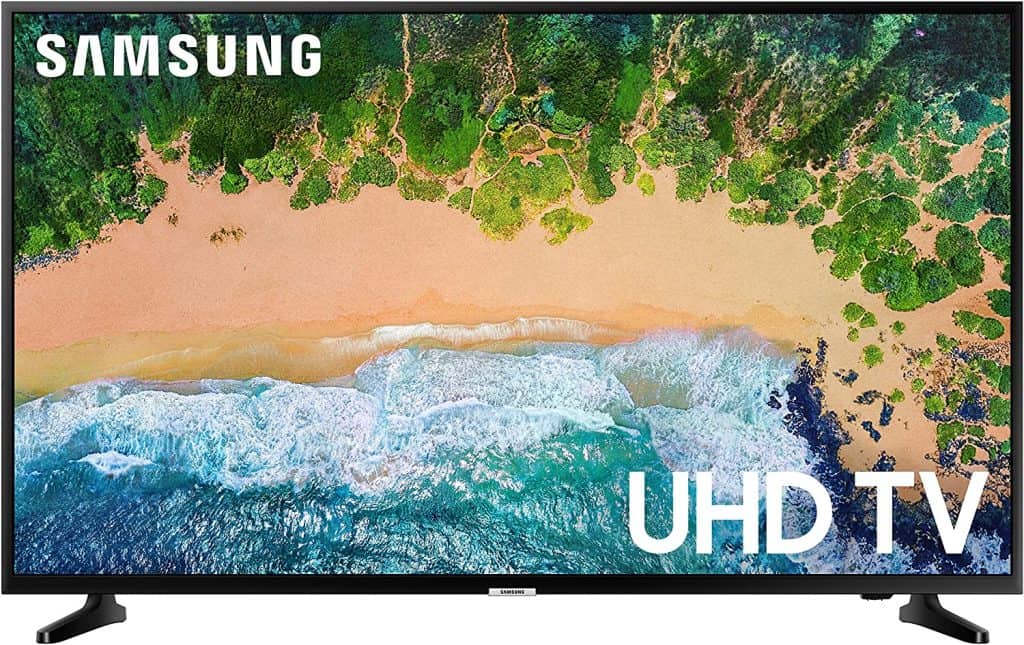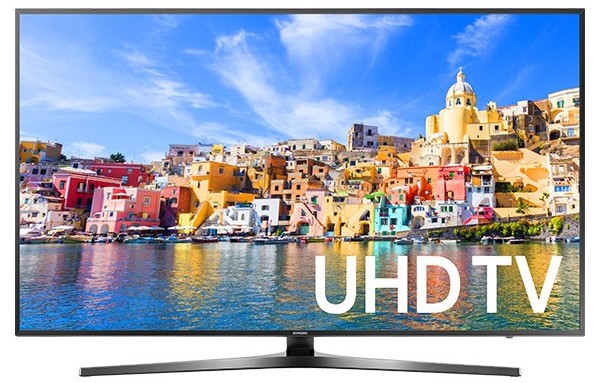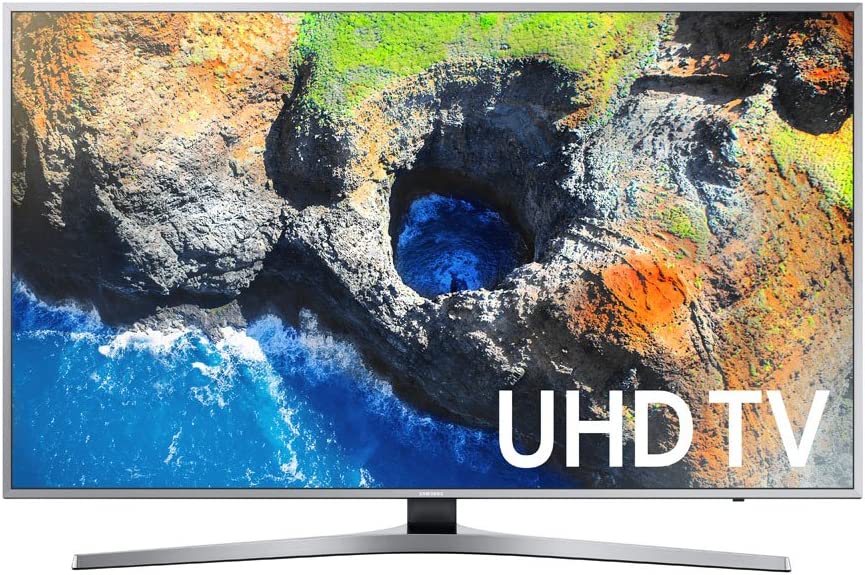Choosing between Samsung 6 Series vs 7 Series can be challenging as these two lines are remarkably similar in several key categories. That said, the 7 Series is clearly the more powerful model in this comparison, as the 6 Series offers many scaled-down features in exchange for a lower price point. If you can’t decide which series you should buy, read our detailed and informative page to learn everything you need to know before you make your decision.
Samsung 6 Series vs 7 Series – Quick Comparison
Samsung 6 Series
The Samsung 6 Series seemingly ticks all of the boxes that make a great TV. It delivers ultra-HD resolution and a reliable smart TV platform, all for a very budget-friendly price. The most significant pros and cons of the 6 Series are:
Pros:
- Some models offer HDR10+ support
- Solid reflection handling
- Great design with plenty of curved panel options
- Above-average native contrast
Cons:
- Doesn’t enable wide color gamuts
- Poor viewing angles
Samsung 7 Series
The 7 Series offers many of the same performance characteristics as the 6 Series, with some improvements and more advanced features. Here are the biggest advantages and disadvantages of Samsung 7 Series models:
Pros:
- Some models offer HDR10+ support
- Smooth and fast OS platform
- Exceptional input lag
- Some models boast impressive colors
Cons:
- Limited brightness
- Poor viewing angles
Samsung 6 Series
Price
As the less-advanced line in this Samsung 6 Series vs 7 Series comparison, the 6 Series includes more affordable models overall. So, if price is one of the deciding factors for you, the 6 Series is a better choice if you want a good budget TV that still has well-built all-around features.
Panel Technology
6 Series models use LED VA panels. The most significant advantages of this panel technology are impressive native contrast ratios, durability, and good image depth. On the other hand, LED VA panels are slower and have inferior viewing angles than other panel types.
Interestingly, most TV sets from the Samsung 6 Series models have a curved panel design. This doesn’t impact the TV’s overall performance but adds to the visual appearance if you appreciate a design that differs from the standard.
Image Processor
Samsung 6 Series TVs employ a robust Quad-Core image processor, a suitable tool for multitasking and quick switching between browning and watching content. This image processor can deliver a respectable performance, although it’s not as fast as the one that comes with 7 Series models.
Motion Technology
6 Series models offer similar response times as 7 Series TVs, with most models delivering full image transitions in around 20 milliseconds or less. There is a bit more blur than in the 7 Series, but not so much that you’ll notice it unless you’re playing fast-paced games or watching sports.
Picture Quality
Contrast Ratio / Black Level
Most 6 Series TVs have an excellent native contrast ratio and can display deep blacks. In simple terms, this means that dark scenes in movies and shows are especially pleasing to the eyes and are displayed with minimal detail loss.
Local Dimming
Samsung 6 Series don’t have local dimming features. Instead, you can find 6 Series TVs with both edge-lit and direct lighting backlight configurations. In the context of backlight effectiveness, the latter option is the better choice.
Peak Brightness
We were surprised to find that TVs from the 6 Series offer better peak brightness values in SDR and HDR. Although they still deliver average to slightly above-average peak brightness numbers, the difference between the two series is especially visible in SDR peak brightness. Models like the KU6600 and the MU6500 thoroughly outperform their 7 Series counterparts.
Color
6 Series models lag behind 7 Series models when it comes to overall color performance. This is primarily because TV sets from this line have a color gamut that’s only good enough for SDR.
They don’t come with the option to enable wide color gamuts for HDR content. Unfortunately, this gamut limitation results in a fairly disappointing color volume for the series, as these TVs perform very poorly when displaying brighter colors.
Viewing Angle
Samsung 6 Series TVs deliver inadequate viewing angles across all available models. As soon as you move slightly off-center, you’ll notice that blacks turn into greys. Additionally, color shifts and brightness loss appear at moderate angles. The 6 Series is not suited for a wide seating arrangement.
Reflections / Anti-glare
Samsung 6 Series models have very similar reflection handling properties as 7 Series TVs, as they have the same semi-gloss screen finish. On average, most 6 Series models reflect around five to six percent of the light that hits their surface. This is slightly higher than average, but still not a problem as long as you’re not watching content in a well-lit environment.
Sound Quality
The sound quality is pretty consistent across all 6 Series models. To be more specific, this includes decent frequency response values with passable but overall unimpressive bass. Moreover, 6 Series TVs can’t get very loud without producing some compression at higher volumes.
Smart TV Platform (Operating System)
Samsung 6 Series models use the Tizen Smart TV OS, a very good TV platform overall. It’s important to mention that the models from this line don’t all use the same Tizen OS version. So, your experience can vary depending on the specific model you buy. For example, the KU6600 employs the 2016 Tizen OS, the MU6500 uses the 2017 version, while the NU6900 comes with the 2018 Tizen OS.
Connectivity
Inputs
All 6 Series models have decent input support features. You can expect all of the standard connectivity options. This includes at least a couple of HDMI ports and at least one USB port. Additionally, all 6 Series TVs come with a Digital Optical Audio Out port and an Ethernet port. The latter allows you to conveniently connect your TV to your router for the highest bandwidth connection possible.
Most 6 Series TVs have decent input lag at their supported resolution, although this can vary significantly from model to model. For instance, the MU6500 offers superb input lag, while the NU6900 and the JU6700 are just average in this category.
Voice Assistants
6 Series TVs don’t use a standardized type of remote like some other Samsung series. For example, the NU6900, MU6500, and JU6700 all use different Samsung remotes. With this in mind, the voice assistant support can vary significantly between specific 6 Series models.
In 6 Series models with a voice assistant option available, it covers all of the basic voice control options. This includes changing between different HDMI inputs, opening apps, searching for content, and performing other simple tasks.
Wireless Technologies
Samsung 6 Series TVs support wireless connection technologies in the form of 2.4GHz and 5.0GHz Wi-Fi. Some 6 Series models also come with Bluetooth support, allowing you to conveniently pair up a set of headsets or additional speakers for a better experience.
Gaming Enhancements
Samsung 6 Series TVs don’t have any noteworthy gaming enhancements. TVs from this line don’t include options like VRR, G-SYNC, or FreeSync. From this perspective, other than having excellent input lag, 6 Series models simply don’t possess the technology to further improve the gaming experience in any way.
Recommended Samsung 6 Series TVs
Samsung MU6500

The MU6500 is an ideal choice if you’re looking for an entry-level TV set that offers excellent value for money. It boasts an attractive curved design, which is challenging to find nowadays. Aside from its design, the MU6500 has good performance characteristics marked by high contrast, excellent input support, and is great at showing content without any stutters.
Samsung NU6900

The Samsung NU6900 is a solid TV for mixed usage. It doesn’t get very bright but delivers an impressive native contrast ratio and great black uniformity. Plus, even though it has relatively narrow viewing angles, it makes up for it with splendid upscaling abilities and good reflection handling. The NU6900 is also one of very few models in its price range that supports HDR10, HDR10+, and HLG. These features help make it stand out among similarly-priced models.
Samsung 7 Series
Price
While models from the 7 Series line are generally pretty affordable, they are still a bit pricier than those from the 6 Series. This is understandable, as 7 Series models come with some enhanced features, which you’ll notice throughout several categories further down the page.
Panel Technology
The 7 Series models use the same LED VA panel technology as the 6 Series TVs. In other words, they are marked by the same strengths and weaknesses as models from the series we’ve discussed above. The only significant difference is that you won’t find as many curved models.
Image Processor
Unlike the fairly generic processor with 6 Series models, Samsung 7 Series TVs utilize a Crystal Processor 4K; a next-gen processor specifically made for Samsung TVs. This processor has better image upscaling abilities, as it employs more sophisticated contrast ratio optimization, color mapping, and resolution adjustments techniques.
Motion Technology
7 Series TVs have a good response time, with minimal faint trails when displaying fast-moving objects. While exact response times will vary from model to model, you can expect a response time of around 20 milliseconds or less.
Picture Quality
Contrast Ratio / Black Level
Even though 6 Series delivers a marvelous native contrast ratio, the 7 Series outperforms it in this category with fantastic contrast ratio values. This is expected from a VA panel, but 7 Series models excel so much that they even surpass some 8 Series models in a head-to-head contrast ratio comparison.
Local Dimming
Like 6 Series models, these TVs also don’t have a local dimming feature. 7 Series models have an edge-lit backlight, which is not bad but not as effective as a full-array/direct lighting configuration.
Peak Brightness
The 7 Series delivers average HDR peak brightness and just okay HDR peak brightness. That said, some 7 Series models like the RU7100 and the TU7000 disappoint in this category and struggle to produce enough brightness even for a moderately-lit viewing environment.
Color
While 7 Series color gamut and color volumes certainly aren’t the best around, they are noticeably better than the color space available in the 6 Series. Most 7 Series TVs support a wide color gamut and cover most of the P3 color space. That said, if you’re looking for the best possible performance in this context, avoid models like the RU7100 and the TU7000, as they don’t support a wide color gamut.
Viewing Angle
The viewing angles on the 7 Series are slightly better than those on the 6 Series. However, they are still inferior, like most VA panels in this context. As you move off-center, you’ll first notice image accuracy, grayscale increase, and lastly, a decrease in brightness.
Reflections / Anti-glare
Identical to the 6 Series, all 7 Series TVs have a semi-gloss screen finish. It reduces reflection intensity but still produces quite a bit of diffusion across the entire screen. This is fine for a dim or average-lit room but could be a problem in a brighter room, as it could lead to a more significant intensity of total reflections.
Sound Quality
7 Series TVs are equally decent in terms of sound quality as 6 Series ones. They offer well-balanced sound profiles, with the bass on the lighter side in all 7 Series models.
Furthermore, the 7 Series also suffers from the same drawback that affects the 6 Series. These TVs can’t get very loud, meaning that they’re better suited for smaller environments instead of larger and noisier environments.
Smart TV Platform (Operating System)
Samsung 7 Series TVs use the same Tizen Smart TV operating system. These specific Smart TV features are pretty similar to those that come with 6 Series models, just with some more advanced settings. As 7 Series models generally use a later OS version than 6 Series TVs, they are a bit smoother, easier to navigate, and faster.
Connectivity
Inputs
If you were to compare the input support features of the 6 Series and 7 Series models side by side, you would notice that there isn’t any difference between the two series. All 7 Series models also have at least a couple of HDMI ports and a minimum of one USB port.
There’s also additional input support in an Ethernet port and a Digital Optical Audio Out port. That said, the 7 Series models have a bit lower input lag across all supported resolutions.
Voice Assistants
Unlike 6 Series models, TVs from the Samsung 7 Series come with fairly standardized remotes, either in the small or medium-sized Samsung remotes. Those that come with the small Smart TV remote also support voice assistant features, which offer you a solid variety of voice control options. These include changing settings, searching content, and utilizing various control features identical to 6 Series and 8 Series models with the same recognizable Samsung small remote.
Wireless Technologies
When it comes to supported wireless technologies, there’s not much room for differentiation. 7 Series models use the same Wi-Fi support in the form of 2.4GHz and 5.0GHz Wi-Fi. They also support Bluetooth technology. In this sense, the 6 Series and the 7 Series are identical in their wireless technologies support features.
Gaming Enhancements
The Samsung 7 Series TVs have very similar features to models from the 6 Series. They offer very low input lag but don’t include any advanced settings like VRR, G-SYNC, FreeSync, or ALLM. With all of this in mind, the two series perform similarly when used as a part of a gaming setup.
Recommended Samsung 7 Series TVs
Samsung KU7000

The Samsung KU7000 is a very good TV for mixed usage. While it’s not free of flaws, particularly when it comes to HDR performance, it’s well-rounded enough to serve as an all-purpose TV. It’s fantastic for playing video games.
Moreover, it performs equally well when it comes to displaying sports, TV shows, and movies. As it’s responsive, fast, and offers above-average uniformity, it can also hold its own as a PC monitor.
Samsung MU7000

The Samsung MU7000 delivers a sharp picture with excellent HDR support. It can display a wide color range and delivers deep and uniform blacks. The MU7000 also has a very low input lag time and has a uniform screen. This means that it’s an excellent choice for both gamers and sports fans. Additionally, some of MU7000’s most notable input specifications include HDR10 and HLG.
SEE ALSO: Our Samsung 7 Series vs 8 Series comparison
Conclusion
After comparing all of the determining factors on this Samsung 6 Series vs 7 Series page, we can say that the latter series stands out as the more powerful option all-around. This is because it delivers better image colors, wider viewing angles, and a more capable image processor, among many other things.
Of course, all of this means that the 7 Series is the more expensive series and shouldn’t be your first choice if you’re primarily deciding based on the overall price. Ultimately, the information we shared with you on this extensive page will hopefully help you pick the more suitable option based on your needs and budget.